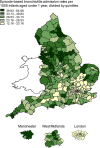Admission to hospital for bronchiolitis in England: trends over five decades, geographical variation and association with perinatal characteristics and subsequent asthma
- PMID: 26342094
- PMCID: PMC4752648
- DOI: 10.1136/archdischild-2015-308723
Admission to hospital for bronchiolitis in England: trends over five decades, geographical variation and association with perinatal characteristics and subsequent asthma
Abstract
Background: Admission of infants to hospital with bronchiolitis consumes considerable healthcare resources each winter. We report an analysis of hospital admissions in England over five decades.
Methods: Data were analysed from the Hospital In-Patient Enquiry (HIPE, 1968-1985), Hospital Episode Statistics (HES, 1989-2011), Oxford Record Linkage Study (ORLS, 1963-2011) and Paediatric Intensive Care Audit Network (PICANet, 2003-2012). Cases were identified using International Classification of Diseases (ICD) codes in discharge records. Bronchiolitis was given a separate code in ICD9 (used in England from 1979). Geographical variation was analysed using Local Authority area boundaries. Maternal and perinatal risk factors associated with bronchiolitis and subsequent admissions for asthma were analysed using record-linkage.
Results: All-England HIPE and HES data recorded 468 138 episodes of admission for bronchiolitis in infants aged <1 year between 1979 and 2011. In 2011 the estimated annual hospital admission rate was 46.1 (95% CI 45.6 to 46.6) per 1000 infants aged <1 year. Between 2004 and 2011 the rates rose by an average of 1.8% per year in the all-England HES data, whereas admission rates to paediatric intensive care changed little (1.3 to 1.6 per 1000 infants aged <1 year). A fivefold geographical variation in hospital admission rates was observed. Young maternal age, low social class, low birth weight and maternal smoking were among factors associated with an increased risk of hospital admission with bronchiolitis.
Conclusions: Hospital admissions for infants with bronchiolitis have increased substantially in recent years. However, cases requiring intensive care have changed little since 2004.
Keywords: Epidemiology; General Paediatrics; Infectious Diseases; Intensive Care; Respiratory.
Published by the BMJ Publishing Group Limited. For permission to use (where not already granted under a licence) please go to http://www.bmj.com/company/products-services/rights-and-licensing/
Figures



Comment in
-
Stemming the tide of hospital admissions for bronchiolitis.Arch Dis Child. 2016 Feb;101(2):118-9. doi: 10.1136/archdischild-2015-309452. Epub 2015 Sep 28. Arch Dis Child. 2016. PMID: 26416899 No abstract available.
References
-
- Glezen WP, Taber LH, Frank AL, et al. Risk of primary infection and reinfection with respiratory syncytial virus. Am J Dis Child 1986;140:543–6. - PubMed
Publication types
MeSH terms
Grants and funding
LinkOut - more resources
Full Text Sources
Other Literature Sources
Medical
